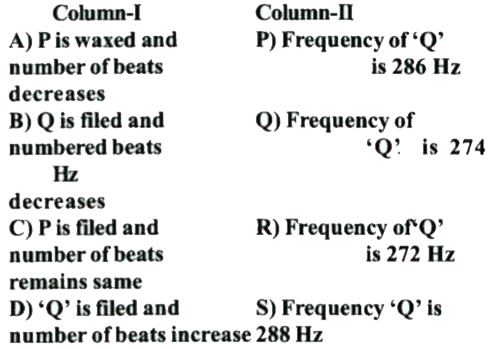A tuning fork when sounded along with a standard source of frequency 300 Hz produces 5 beats s−1. The tuning fork when loaded by some wax is again found to give 5 beat s−1 with the standard source. The original frequency of the fork is
290 Hz
295 Hz
305 Hz
310 Hz
The correct Answer is:C
The frequency of the fork may be 305 Hz or 295 Hz. When loaded, the frequency decreases. If it is 295 Hz, then the number of beats/sec will increase (more than 5). Hence it must be 305 Hz
Topper's Solved these Questions
- WAVE MOTIONBOOK - MARVEL PUBLICATIONCHAPTER - WAVE MOTIONEXERCISE - Test your grasp
15 Videos
- SURFACE TENSION BOOK - MARVEL PUBLICATIONCHAPTER - SURFACE TENSION EXERCISE - MULTIPLE CHOICE QUESTIONS . (TEST YOUR GRASP )
10 Videos
- WAVE THEORY OF LIGHT AND POLARISATION BOOK - MARVEL PUBLICATIONCHAPTER - WAVE THEORY OF LIGHT AND POLARISATION EXERCISE - TEST YOUR GRASP -10
15 Videos
Similar Questions
Tuning fork A when sounded with a tuning for B of frequency 480 Hz gives 5 beats per second. When the prongs of A are loaded with wax, it gives 3 beats per second. The original frequency of A is
View SolutionA tuning fork of frequency 100 when sounded together with another tuning fork of unknown frequency produces 2 beats per second. On loading the tuning fork whose frequency is not known and sounded together with a tuning fork of frequency 100 produces one beat, then the frequency of the other tuning fork is
View Solution
Knowledge Check
A tuning fork 'P' of frequency 280Hz produces 6 beats/s with unknown tuning fork 'Q'
 AABCDQRSRBABCDQRQPCABCDP.QQ.RR.SPDABCDR.SQ.RSR
AABCDQRSRBABCDQRQPCABCDP.QQ.RR.SPDABCDR.SQ.RSRWhen a tuning fork and a source of frequency 200 Hz were sounded together, 4 beats were heard per second. When the tuning fork was loaded with some wax, again 4 bets were produced per second The original frequency of the tuning fork was
A200 HzB204 HzC196 HzD220 HzTurning fork A of frequency 305 Hz produces 5 beats s−1 with another turing fork B. After filling tuning fork B, it produces 3 beats s−1 with A. The frequency of B before filling was
A300 HzB313 HzC310 HzD308 Hz
Tuning fork A of frequency 258 Hz gives 8 beats with a tuning fork B. When the tuning fork A is filed and again A and B are sounded the number of beats heard decreases. The frequency of B is
View SolutionWhen a tuning fork A of unknown frequency is sounded with another tuning fork B of frequency 256Hz, then 3 beats per second are observed. After that A is loaded with wax and sounded, the again 3 beats per second are observed. The frequency of the tuning fork A is
View SolutionA tuning fork of frequency 100 when sounded together with another tuning fork of unknown frequency produces 2 beats per second. On loading the tuning fork whose frequency is not known and sounded together with a tuning fork of frequency 100 produces one beat, then the frequency of the other tuning fork is
View SolutionTuning fork A when sounded with a tuning for B of frequency 480 Hz gives 5 beats per second. When the prongs of A are loaded with wax, it gives 3 beats per second. The original frequency of A is
View SolutionA tuning fork of frequency 100 when sounded together with another tuning fork of unknown frequency produces 2 beats per second. On loading the tuning fork whose frequency is not known and sounded together with a tuning fork of frequency 100 produces one beat, then the frequency of the other tuning fork is
View Solution
